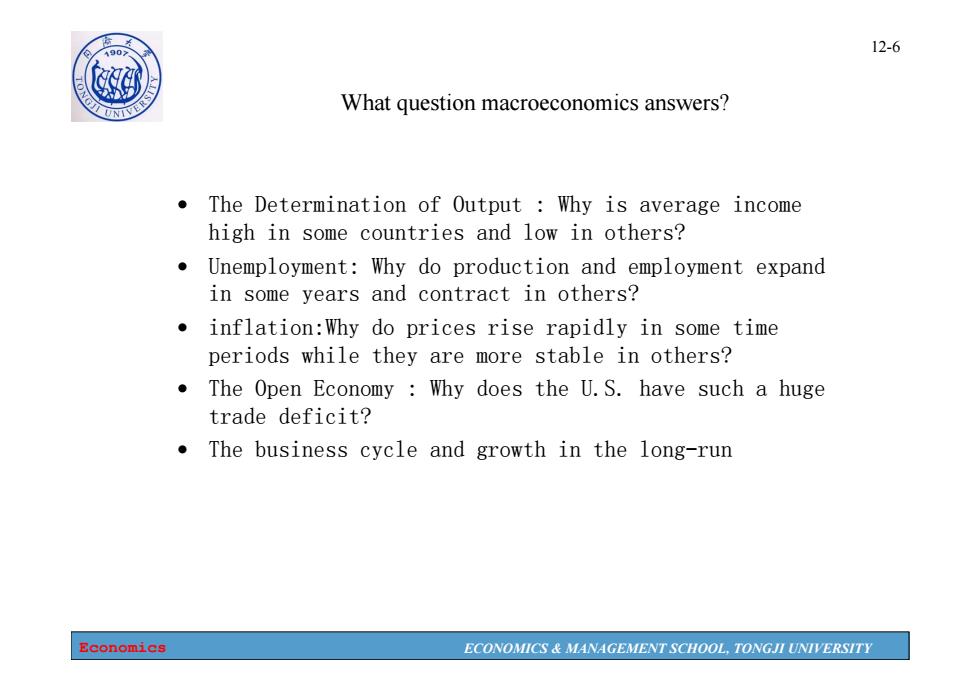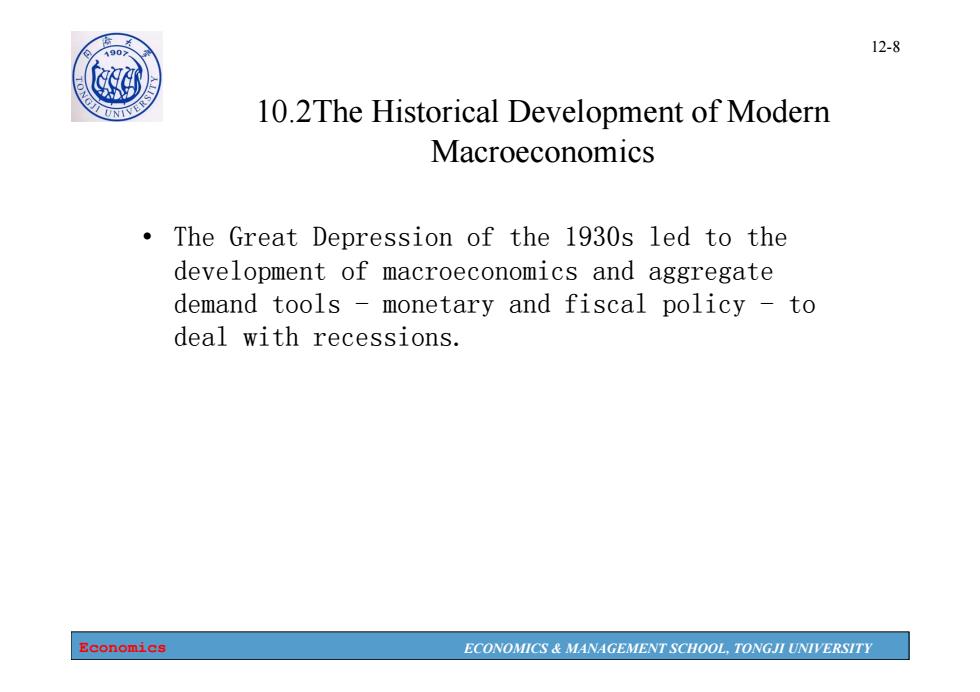
1907 12-6 What question macroeconomics answers? The Determination of Output Why is average income high in some countries and low in others? Unemployment:Why do production and employment expand in some years and contract in others? inflation:Why do prices rise rapidly in some time periods while they are more stable in others? The Open Economy Why does the U.S.have such a huge trade deficit? The business cycle and growth in the long-run Economics ECONOMICS MANAGEMENT SCHOOL,TONGJI UNIVERSITY
Economics ECONOMICS & MANAGEMENT SCHOOL, TONGJI UNIVERSITY 12-6 What question macroeconomics answers? • The Determination of Output : Why is average income high in some countries and low in others? • Unemployment: Why do production and employment expand in some years and contract in others? • inflation:Why do prices rise rapidly in some time periods while they are more stable in others? • The Open Economy : Why does the U.S. have such a huge trade deficit? • The business cycle and growth in the long-run

12-7 0 Objectives of Macroeconomics (a)high levels and rapid growth of output and consumption Loutput is usually measured by the gross domestic product (GDP),GDP should be close to potential GDP,the maximum sustainable or high-employment level of output]; (b)low unemployment rate and high employment, with an ample supply of good jobs; (c)price-level stability (or low inflation). .(d)balance of international payment Economics ECONOMICS MANAGEMENT SCHOOL,TONGJI UNIVERSITY
Economics ECONOMICS & MANAGEMENT SCHOOL, TONGJI UNIVERSITY 12-7 Objectives of Macroeconomics • (a) high levels and rapid growth of output and consumption [output is usually measured by the gross domestic product (GDP), GDP should be close to potential GDP, the maximum sustainable or high-employment level of output]; • (b) low unemployment rate and high employment, with an ample supply of good jobs; • (c) price-level stability (or low inflation). • (d) balance of international payment

490 12-8 10.2The Historical Development of Modern Macroeconomics The Great Depression of the 1930s led to the development of macroeconomics and aggregate demand tools -monetary and fiscal policy -to deal with recessions. Economics ECONOMICS MANAGEMENT SCHOOL,TONGJI UNIVERSITY
Economics ECONOMICS & MANAGEMENT SCHOOL, TONGJI UNIVERSITY 12-8 10.2The Historical Development of Modern Macroeconomics • The Great Depression of the 1930s led to the development of macroeconomics and aggregate demand tools - monetary and fiscal policy - to deal with recessions

12-9 From Classical to Keynesian Economics Pre-Depression economists are called Classical economists. They felt the market was self-adjusting. They focused on long-run issues such as growth. Economics ECONOMICS MANAGEMENT SCHOOL,TONGJI UNIVERSITY
Economics ECONOMICS & MANAGEMENT SCHOOL, TONGJI UNIVERSITY 12-9 From Classical to Keynesian Economics • Pre-Depression economists are called Classical economists. • They felt the market was self-adjusting. • They focused on long-run issues such as growth

12-10 10 From Classical to Keynesian Economics Depression-era economists are called Keynesians after John Maynard Keynes. They focused on short-run economic issues. Keynes is the founder of macroeconomics and author of The General Theory of Employment,Interest and Money. Economics ECONOMICS MANAGEMENT SCHOOL,TONGJI UNIVERSITY
Economics ECONOMICS & MANAGEMENT SCHOOL, TONGJI UNIVERSITY 12-10 From Classical to Keynesian Economics • Depression-era economists are called Keynesians after John Maynard Keynes. • They focused on short-run economic issues. • Keynes is the founder of macroeconomics and author of The General Theory of Employment, Interest and Money